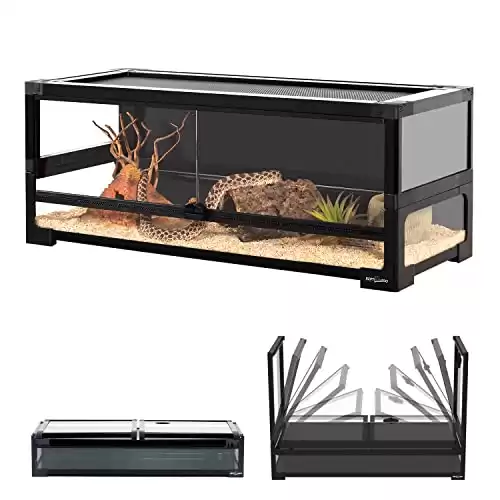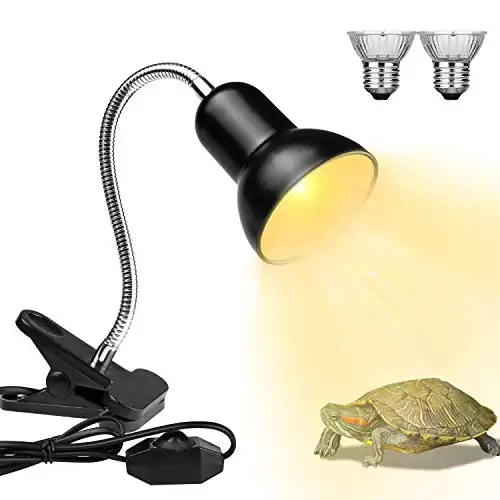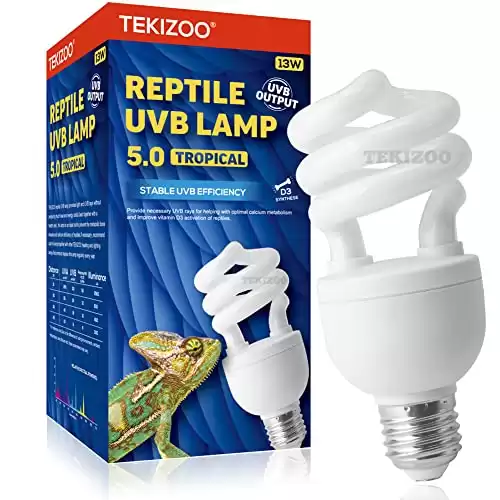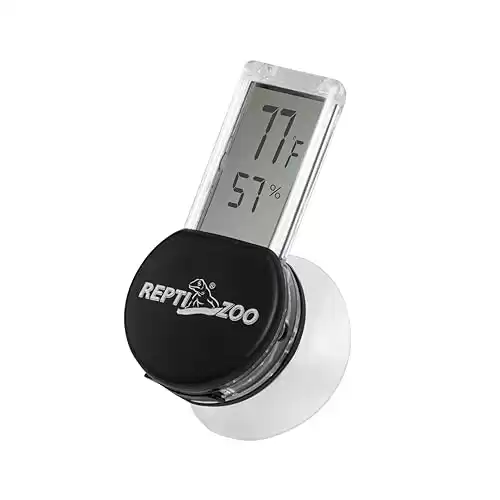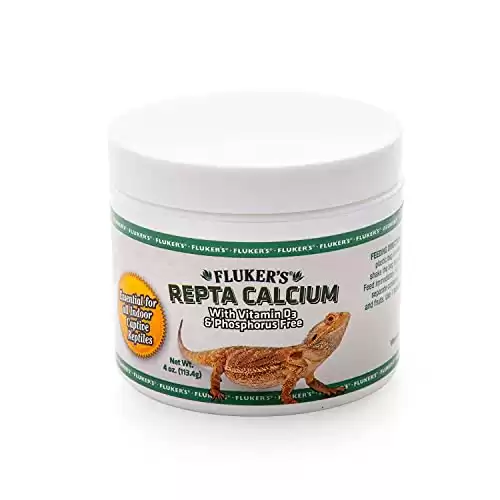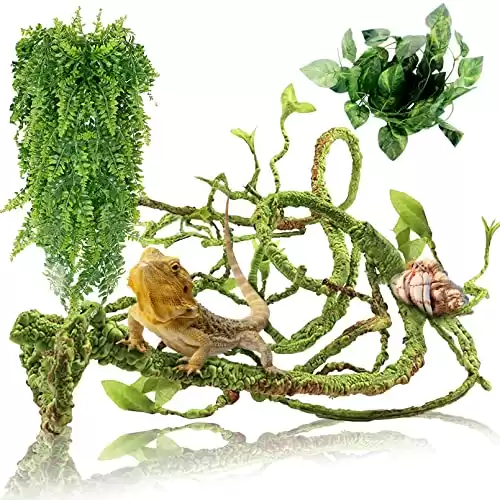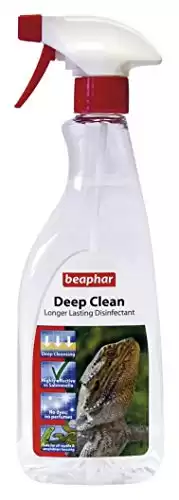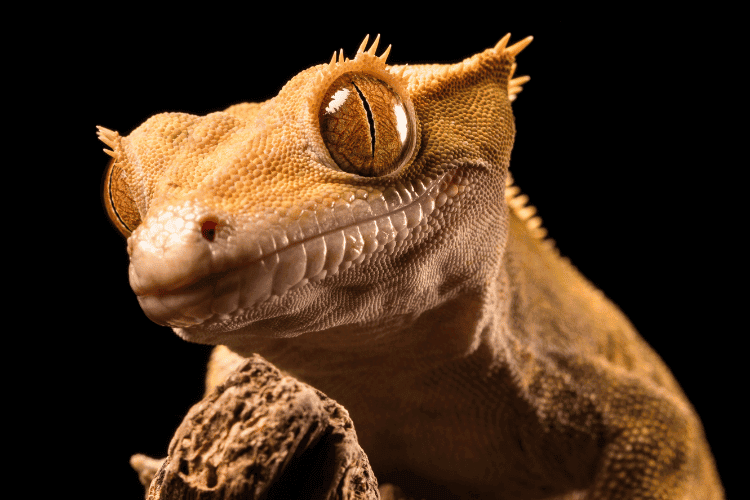
Crested geckos are curious and playful little guys. They love to explore their enclosures and climb around. They’re also very social and enjoy being around their owners.
If you’re looking for a pet that is both easy to care for and has a lot of personality, this species of gecko is a great choice. They’re sure to bring you years of joy!
So, let’s not keep you waiting and get right into our full guide about caring for crested geckos. We cover everything from their feeding and breeding habits to their temperaments and lifespan.
How Do Crested Geckos Look?
A crested gecko, often called an eyelash gecko, is a small, arboreal lizard native to New Caledonia. It’s one of the most popular pet geckos due to its docile nature, ease of care, and wide range of color morphs.
Additionally, geckos have a distinctive crest of scales along their backs, which gives them their name. They also have a long tail that they can use to help them climb. Their toes are slightly webbed as well, which helps them grip onto surfaces.
Interestingly, this gecko species come in a variety of colors, including shades of brown, orange, red, and yellow. They can also have patterns, such as stripes or spots.
You’ll notice that these geckos have large, round eyes with vertical pupils, and that their skin is smooth and has a slightly translucent quality.
Like most species of lizards, your gecko has a forked tongue that it uses to catch insects and sheds its skin regularly.
Where Do Crested Geckos Live?
Crested geckos are native to the island country of New Caledonia.
They’re arboreal lizards, meaning they live in trees. Their natural habitat is characterized by warm temperatures, high humidity, and plenty of vegetation.
The average temperature in New Caledonia ranges from 75℉ to 8℉. The humidity is typically high, around 70%. These geckos are well-adapted to these conditions and can tolerate a wide range of temperatures and humidity levels.
The terrain in New Caledonia is varied, with rainforests, mountains, and beaches. While geckos can be found in all of these habitats, they prefer to live in the rainforests.
What Is the Ideal Captive Habitat for Crested Geckos?
The ideal captive habitat for crested geckos should provide them with a comfortable, healthy, and stimulating environment.
Here are some of the key things to consider when setting up a crested gecko enclosure:
Size
The enclosure should be large enough for the gecko to climb and explore. A minimum size of 20 gallons is recommended for a single crested gecko, but larger is always better.
Type
A glass tank is the best option for crested geckos, as it allows you to see them clearly and provides good ventilation. You can also use a wooden
Temperature Gradient
Your pet gecko needs a temperature gradient in their enclosure, with a warm side of around 80-85℉ and a cool side of around 75℉. You can create this gradient by using a
A humidity gauge would also be pretty helpful to ensure the environment has the correct humidity level your gecko desires.
Lighting
Crested geckos need UVB lighting to help them synthesize vitamin D3. Pro tip: UVB lamps should be replaced every 6 months.
Substrate
A loose substrate, such as coconut fiber, paper towels, or bark, is best for crested geckos. This will help keep their skin moist and prevent impaction.
Decor
Geckos need plenty of things to climb on and hide in. You can provide them with rocks, branches, and plants.
Hiding spots
Any gecko needs a place to feel safe and secure. You can provide them with hiding spots, such as cork bark or half logs.
It’s also important to keep the enclosure clean and free of bacteria. Spot-clean the enclosure regularly and thoroughly clean it once a month.
Essential Equipment for Gecko Keeping
- A 20-gallon tank
- A heat lamp
- A UVB light
- Food and
water bowl - A
thermometer - Substrate (paper towel, reptile carpet…etc.)
- Calcium and multivitamin supplements
- Feeding tongs
- Branches or climbing perches
- Cleaning supplies
What Are the Ideal Tank Mates for Crested Geckos?
Your geckos are solitary animals and shouldn’t be housed with other crested geckos or other animals. They’re territorial and can be aggressive towards other geckos, even of the same sex. They can also transmit diseases to each other.
If you’re considering housing a crested gecko with another animal, it’s important to consult with a veterinarian or experienced reptile keeper. They can help you assess the compatibility of the two animals and recommend a safe way to house them together.
What Are the Feeding Habits of Crested Geckos?
Crested geckos are omnivorous, meaning they eat both plants and animals. Their diet should consist of a balanced mix of live prey, insects, and plant matter.
The feeding frequency for crested geckos will vary depending on their age and size as well.
Juvenile geckos should be fed 2-3 times a day, while an adult crested gecko can be fed once a day. Avoid overfeeding, as this can lead to health problems.
That said, here are some specific dietary considerations for your lizard:
- Leafy greens: Your pet needs a staple of leafy greens in their diet. Some good options include collard greens, mustard greens, and dandelion greens. These greens provide essential vitamins and minerals, such as
calcium , vitamin A, and vitamin C. - Live insects: They’ll also need to eat live insects, such as crickets, dubia roaches, and mealworms. These insects provide essential protein and other nutrients.
- Fruits and vegetables: Include bananas, mangoes, and carrots. However, these should only be a small part of their diet.
- Calcium supplementation: These geckos are prone to a condition called metabolic bone disease, which is caused by a lack of
calcium . It’s important to dust their insect prey withcalcium powder several times a week to prevent this condition. - Multivitamin supplement: A multivitamin supplement can also be added to their diet occasionally to ensure they receive all the essential nutrients they need.
- Fresh water: Make sure your gecko has access to fresh, clean water at all times. They may not drink much water, but it’s vital to provide it for them anyway.
What Is the Temperament of Crested Geckos?

These geckos are generally docile and friendly animals. They’re not as skittish as some other lizards, and they can be handled relatively easily. However, individual geckos may vary in their temperament, and some may be more shy or reserved than others.
Remember that your pet geckos are still wild animals though, and they may not always enjoy being handled. It’s best to start with short handling sessions and gradually increase the time you spend with the gecko.
Additionally, wash your hands before and after handling. This will help to prevent the spread of germs. Avoid handling the gecko during feeding or breeding time too. These are times when the gecko may be more stressed and less likely to enjoy being handled.
Check out these expert tips for handling your gecko:
- Approach the gecko calmly and slowly. Avoid making any sudden movements or loud noises.
- Support the gecko’s body with both hands. This will help to make them feel secure and prevent them from feeling unbalanced.
- Avoid gripping the gecko too tightly. This can cause them stress or pain.
- Talk to the gecko in a soft voice. This can help to calm them down and make them feel more comfortable.
- End the handling session if the gecko becomes stressed or agitated.
What Are the Common Health Issues for Crested Geckos?
A crested gecko is generally healthy animals, but it can be susceptible to some common health problems. In case you notice abnormal signs or symptoms, check with a specialized vet right away.
That said, here are some of the most common health problems in these species of gecko:
Metabolic Bone Disease (MBD)
MBD is a condition caused by a lack of
To prevent MBD, provide your gecko with a balanced diet that includes calcium-rich foods, such as crickets and leafy greens. You should also provide your gecko with a UVB light, which helps them synthesize vitamin D.
Intestinal Parasites
A pet gecko can sometimes be infected with intestinal parasites, such as roundworms and hookworms. These parasites can cause digestive problems, weight loss, and other health problems.
To deal with parasite infections, have your gecko’s fecal matter examined regularly by a veterinarian. You should keep your gecko’s habitat clean and sanitary as well.
Respiratory Infections
Geckos can also be susceptible to respiratory infections. These infections can be caused by bacteria or viruses.
Signs of a respiratory infection include wheezing, nasal discharge, and labored breathing. If you think your gecko may have a respiratory infection, take them to a veterinarian immediately.
Impaction
Impaction is a condition that occurs when a gecko ingests something that they can’t digest. This can include loose substrate, such as sand or gravel. Impaction can be a serious problem and can even be fatal.
With impaction, provide your gecko with a substrate that they can’t ingest. You should also avoid feeding your gecko large insects or bones.
Tail Rot
Tail rot is a condition that occurs when the gecko’s tail becomes necrotic. This can be caused by poor husbandry, such as inadequate humidity or temperature, or by injuries. Tail rot can be a serious problem and can even lead to the loss of the tail.
To prevent tail rot, maintain a clean and hygienic environment and provide your gecko with the proper humidity and temperature.
What Are the Lifespan and Size of Crested Geckos?
A crested gecko has an average lifespan of 10-15 years in captivity, with some individuals living up to 20 years.
They’re relatively small lizards, reaching an average length of 8-10 inches (20-25 cm) from head to tail. Males are typically larger than females too.
Here’s a more detailed look at the lifespan and size of crested geckos at different life stages:
- Hatchling: Crested geckos hatch at around 2 inches (5 cm) long.
- Juvenile: Juvenile crested geckos grow rapidly and can reach lengths of 6-8 inches (15-20 cm) within their first year.
- Adult: Adult crested geckos reach their full size at around 3 years old. They typically measure 8-10 inches (20-25 cm).
What Are the Breeding Habits of Crested Geckos?
Crested geckos are sexually mature at around 1-year-old. The breeding season for crested geckos is from March to September. During this time, the female will lay 1-2 clutches of 2 eggs each. The eggs will hatch after about 60 days.
Expert tips for breeding crested geckos in captivity:
- Introduce the male and female geckos to each other gradually. You can do this by placing them in separate enclosures that are next to each other.
- Monitor the geckos closely for signs of breeding. The female gecko will become more active and may start to lay eggs.
- Remove the eggs from the enclosure as soon as they’re laid. This will prevent the male gecko from eating them.
- Place the eggs in a container with a moist substrate. The eggs will hatch after about 60 days.
Are There Legal Considerations for Owning a Crested Gecko?
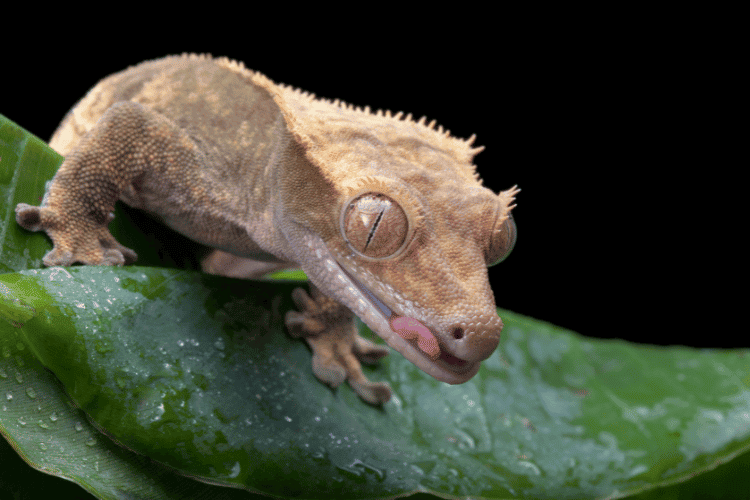
Yes, there are legal considerations for owning a crested gecko. The specific requirements and restrictions vary depending on the region or jurisdiction.
In the United States, crested geckos aren’t considered an invasive species and are legal to own in most states. However, there are some states that have restrictions on the ownership of reptiles, so check with your local laws before acquiring a crested gecko.
In some countries, such as Australia and New Zealand, crested geckos are an invasive species and are illegal to own. So, research the legal requirements in your area before purchasing a crested gecko.
Additional Resources
Books:
- “Crested Geckos” by Adam Black
- “Crested Gecko in Captivity” by Robbie Hamper
- “Crested Gecko as Pets Made Simple” by Markus J. Muench
Forums:
Case Study
Read this reddit post where a gecko mother writes about her love for her little gecko and shares pictures of him hanging off his toys. There’s also little Odin hanging off bamboo. Both cases should show you how wonderful these creatures are.
FAQs
Can I keep multiple crested geckos together?
Your pet geckos are solitary animals and should not be kept together. They can become stressed and aggressive if housed together, and they may even fight.
If you want to keep more than one crested gecko, you’ll need to provide them with separate enclosures.
Is a crested gecko a beginner pet?
A crested gecko can be good beginner pets for people who are willing to do their research and provide them with the proper care. They’re relatively low-maintenance animals, but they still have some specific needs.


